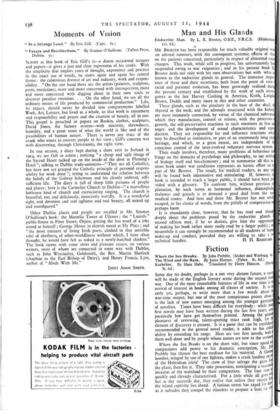"In a Strange Land." By Eric Gill. (Cape. 6s.)
SLIGHT as this book of Eric Gill's is—a dozen occasional lectures and papers—it gives a just and clear expression of his credo. With the simplicity that implies years of thought, experience and practice in the exact use of words, he states again and again his central theme: the calamitous divorce of art and industry, work and respon- sibility. "On the one hand there are the artists (painters, sculptors, poets, musicians), more and more concerned with introspectiOn, more and more concerned with digging about in their own souls to discover peculiar emotions. . . . On the other hand, we see all the ordinary means of life produced by commercial production." Life, he argues, should never be divided into compartments labelled Work, Art, Leisure, but lived as a whole, so that work is enjoyment and responsibility and prayer and the creation of beauty, all in one. This gospel is preached in papers on Ruskin, clothes, sculpture, David Jones, the factory system—with sincerity, shrewdness, humility, and a great sense of what the world is like and of the possibilities of human nature. There is never any trace of the crank who wants to convert people to his view ; Gill's concern was with discovering, through Christianity, the right view.
In one section, a diary kept during a short visit to Ireland in • 1914, we see Gill in action ; noticing "a cheap and ugly imago of the Sacred Heart tacked up on the inside of the door at Fleming's Hotel "; talking to Dublin trade-unionists--" They are all Catholics, but have not yet grasped the Catholic principle of personal respon- sibility for work done "; trying to understand the relation between the beliefs of the Galway fisherman and his cleanly ordered, self- sufficient life. The diary is full of sharp little pictures of people and places: here is the Carmelite Church in Dublin—" a marvellous hothouse kind of church and excruciating singing. The church is beautiful, too, and deliciously, innocently wor!dly. It is a wonderful sight, real devotion and real ugliness and real beauty, all mixed up and transfigured."
Other Dublin places and people are recalled in Mr. Seumas O'Sullivan's book: the Martello Tower of Ulysses ; the " Laurels " public-house in Fleet Street; Orpen, getting the last word of a joke aimed at himself ; George Moore in skittish mood at Ely Place ; and "the most eminent of living Irish 'poets, clothed in that invisible robe of aloofness1 of other-worldliness without which, I have often thought, he would have felt as naked as a newly-hatched chicken." The book opens with some short and p!easant essays, on various writers, most of whom are connected in some way with Dublin, such as John Winstanley, Goldsmith, the Rev. Martin Sherlock (chaplain to the Earl Bishop- of Derry), and Henry Francis Lyre, author of "Abide With Me."
JANET ADAM SMITH.


























 Previous page
Previous page